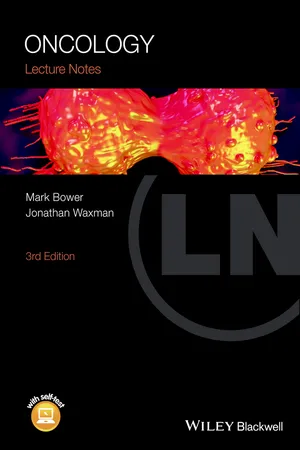
- English
- ePUB (mobile friendly)
- Available on iOS & Android
Oncology
About this book
Cancer is one of the most exciting specialties in medicine. This book aspires to convey the authors' enthusiasm for oncology and this new edition of Oncology Lecture Notes is a must for students and trainees.
There has been a revolution in the practice of oncology. The changes are due to amazing advances in basic science, and the development of new drugs and successful immunisation programmes that have followed. Cancer death rates have fallen and this is in part due to radical new treatments, effective screening programmes, and also, as a result of popular movements for change in patient care, and decreased exposure to carcinogens.
Completely revised and updated, this new edition of Oncology Lecture Notes describes advances in molecular biology research and highlights the importance of patient perspectives in cancer care. The text includes many new figures and tables, an update of molecular biology and highlights new treatments. With learning objectives and key point summaries in each chapter, Oncology Lecture Notes is an ideal introduction to the biological basis and principles of treatment in oncology.
Includes a companion website at www.lecturenoteseries.com/oncology featuring cases and self-assessment MCQs.
Frequently asked questions
- Essential is ideal for learners and professionals who enjoy exploring a wide range of subjects. Access the Essential Library with 800,000+ trusted titles and best-sellers across business, personal growth, and the humanities. Includes unlimited reading time and Standard Read Aloud voice.
- Complete: Perfect for advanced learners and researchers needing full, unrestricted access. Unlock 1.4M+ books across hundreds of subjects, including academic and specialized titles. The Complete Plan also includes advanced features like Premium Read Aloud and Research Assistant.
Please note we cannot support devices running on iOS 13 and Android 7 or earlier. Learn more about using the app.
Information
Part 1
Introduction to oncology
1
What is cancer?
Learning objectives
- List the histopathological features of cancer

- Classify cancers and recognize their nomenclature

- Explain the epidemiology of cancer

Epidemiological perspective
- 434,115 new cases of cancer
- 159,178 deaths from cancer
Box 1.1 Understand the Geek-speak of epidemiology
- Cancer incidence is the number of new cancer cases arising in a specified period of time.
- Cancer prevalence is the number of people who have received a diagnosis of cancer who are alive at any given time, some of whom will be cured and others will not.
- Cancer mortality is the number of deaths due to cancer in a specific time period and defined population.
- Age-specific rates. To overcome problems of different population age structures, age-specific rates for an age range (usually 5–10 years) are published. For example, age-specific incidence rates of breast cancer in women aged 50–54 years.
- Standardization is used to remove the effect of a variable that you are not interested in studying (often age or gender).
- Age standardized rates. This corrects the crude rates to a “standardized population”. The same “standard population” is used for all rates to allow comparisons.
- Standardized ratios. Standardized incidence ratio (SIR) and mortality ratio (SMR) compare the age-specific rate in the study population with those of a control population.
- Relative risk (also known as risk ratio) is the ratio of the risk of disease (e.g. lung cancer) amongst people exposed to a risk factor (e.g. smoking) to the risk amongst unexposed people (e.g. non-smokers). Data are calculated from cohort studies from which the incidence can be calculated.
- Odds (as every gambler knows) is the ratio of the occurrence of an event to that of non-occurrence. If 20 out of every 100 smokers develop lung cancer, the odds are 20:80 or 1 in 4 (whilst the probability of developing lung cancer is 20/100 or 0.2).
- Odds ratio compares the odds of an event in two different populations.
| Age | 0–14 yr | 15–24 yr | 25–49 yr | 50–74 yr | >74 yr |
| Male | Leukaemia | Testis | Testis | Prostate | Prostate |
| Brain tumour | Hodgkin lymphoma | Melanoma | Lung | Lung | |
| Lymphoma | Leukaemia | Bowel | Bowel | Bowel | |
| Female | Leukaemia | Hodgkin lymphoma | Breast | Breast | Breast |
| Brain tumour | Melanoma | Melanoma | Lung | Bowel | |
| Lymphoma | Ovary | Cervix | Bowel | Lung |
Sociological pe...
Table of contents
- Cover
- QR code
- Title page
- Copyright
- Preface
- About the companion website
- Part 1 Introduction to oncology
- Part 2 Types of cancer
- Part 3 The practice of oncology
- Index
- EULA